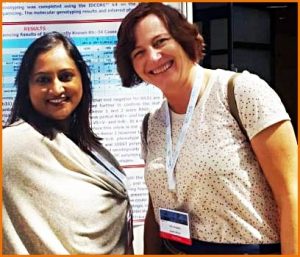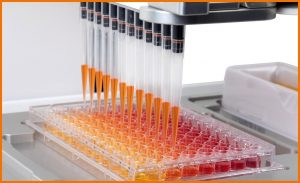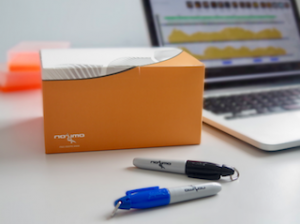The following interview is part of our interview series that we are conducting with Key Opinion Leaders, Experts and Business Managers within the HLA field. This time Dr. Lavendri Govender and Dr. Ute Jentsch from South-African National Blood Service talk about their experiences and thoughts on technology improvements. We hope this series will shed a light on trends and challenges within the profession and will be helpful to both new and experienced HLA experts.

Dr.Lavendri Govender and Dr.Ute Jentsch
What is your role in the lab?
Lavendri Govender is a molecular expert, she oversees and conducts Research and Development in the Specialised Laboratory Services SANBS. Dr. Ute Jentsch is the Lead Consultant in Pathology and has pathology oversight at SANBS SLS laboratories in South Africa.
What is the biggest challenge your laboratory is currently facing?
Since we started implementing the Holotype HLA 11 loci workflow in our laboratory, we had two main challenges. The biggest challenge at first was the high costs of implementing the NGS workflow. We had to make a high level of financial and technological investments, however we also knew that it would be worth it in the long term to capacitate SANBS and SA in NGS; so that we are not left behind and also to add to patient and donor care. Furthermore, we needed to build the adequate staff capacity for the specialized skills since a high resolution HLA typing workflow was new to our lab. Fortunately, the Omixon field team provided, and still provides us, with a high level of support in the analysis and interpretation of NGS based sequencing data. We have been working together with Omixon and their local distributor Inqaba Biotec, for more than 2 years now and together with their support we have risen to the challenge and have been able to use the Holotype HLA workflow in routine to type our transplant patients and donors.
What benefits should a new technology bring to the lab in order to be appealing?
Implementation of a new technology, in this case NGS, includes for us several benefits; generating whole gene sequences, unambiguous genotyping results at 3-field resolution or higher, the ability to batch larger number of samples, and last but foremost, it gives us the ability to improve patient and donor management. In addition, it is also critical that we now have the tools to map South African’s allele frequencies, uniqueness and can foster genetic profiling, moving our technology from pheno- to genotyping. Since we are now also using the Monotype ABO typing kit we can do this for both the HLA and ABO genes. Last but not least, I would mention the Center of Excellence program, an exclusive cooperation with Omixon to become a COE hub for African countries. We aim to host workshops while training experts and spreading knowledge within the NGS users locally in SA but also beyond our borders. Assisting the HLA community in transferring the knowledge and expertise to labs that have not yet adopted NGS for HLA, is also a very important benefit of these kinds of partnerships.
Are you considering implementing automation in your lab in the near future, if so which robot would you like to use in routine and why?
Yes, we are considering automation and ultimately to automate certain steps of the process and reduce TAT, but we are still exploring whether this is the way for us to go, especially with the Omnitype kit in sight.

Pipette Robot
What aspects of Holotype HLA would benefit most from automation?
In my opinion, Holotype HLA is an easy to perform protocol with many safe-stopping points, so in general for a low-medium throughput lab, automation is not crucial. However, we feel that it would be beneficial to automate the amplicon quantification and dilution step as this takes up a significant amount of time with the current Holotype HLA 11 loci workflow. Having said this, with the introduction of the Omnitype (multiplex of 11 loci) automation is no longer imperative, so we are very much looking forward to this new and shorter protocol.
What do you think are the disadvantages of automation?
To us, one of the major disadvantages is the high costs that go along with implementing automation, especially for a medium throughput laboratory. In addition, when all the routine work is performed by automation there is a risk for the technicians to lose their technical skills. It is always beneficial to have experience with the manual workflow, at least as backup to the automation.
What is the biggest hurdle to overcome when implementing new technology? NGS specifically?
Although implementing NGS requires an initial investment, the economics of adopting NGS are undeniably favorable in the long run, but I must say that we were lucky in that regard that we already had a MiSeq at our department. Probably the biggest hurdle is to have all technicians be trained at the level that they can do the interpretation and analysis of the NGS data and HLA typings by themselves. NGS based HLA typing requires a specialized skill which takes time, experience, and the proper support of the company.
Which one do you prefer to use: singleplex or multiplex HLA genotyping by NGS?
We would prefer to use a multiplexed HLA typing kit due to a reduction in turnaround time, less manual intervention and to increase throughput. The less steps the technician has to perform manually, the less risk of error and therefore less risk of repeats. However, I have to add to this that it is still the highest priority to get good quality and robust results, and we know we can rely on that when using the Holotype HLA (singleplex) protocol. The multiplex will only be adopted when we will have the same experience and trust in the product.

Holotype HLA
What role do you see for HLA Typing when every child’s genome is sequenced at birth?
At the moment we are not in the position of supporting comprehensive precision medicine, including sequencing every child’s genome at birth as SA does not have the necessary maturity, capacity and legal / ethical framework at this point in time on a national level. We do believe that the NGS we are doing now and the required capacity that we are building is work in progress to that goal in the future; should it serve our population well at a public health level.
What are your major expectations from an NGS service provider?
Next to providing us with a good product that we can rely on, one of most important aspects the company has to deliver is good technical and analysis support, in an easy accessible way. In this specialized field the support and the open communication through regular meetings with the supplier is extremely important, even when the product is of a high standard. Next to that, we expect an NGS workflow provider to arrange educational events, like webinars, user group meetings and workshops, to give us the ability to learn and grow. Last, but not least, it is important to have a good channel partner, so you know that you will not only have good remote support but also locally, and luckily we have both.
We would like to thank Dr. Lavendri Govender and Dr. Ute Jentsch for offering their time to answer our questions!
If you are interested in any of our products please do not hesitate to contact us for further information via sales@omixon.com or product@omixon.com






